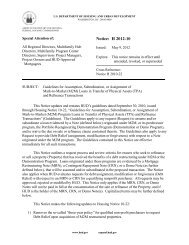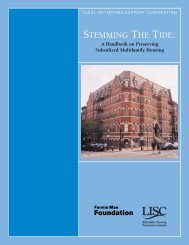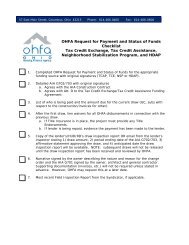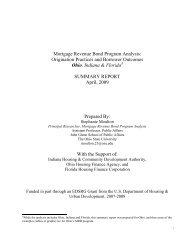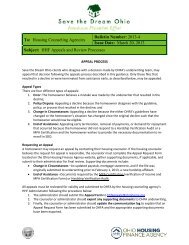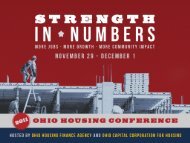OHFA Annual Plan - Ohio Housing Finance Agency
OHFA Annual Plan - Ohio Housing Finance Agency
OHFA Annual Plan - Ohio Housing Finance Agency
Create successful ePaper yourself
Turn your PDF publications into a flip-book with our unique Google optimized e-Paper software.
Very Low-Income <strong>Housing</strong> AssistanceBackground DataThe U.S. Department of <strong>Housing</strong> and Urban Development (HUD) defines a “very lowincome”household as one with an income that is at or below 50 percent of an area’s medianincome (AMI). The state has the following composition of very low-income households:• 791,429 households under 50 percent area median gross income (AMGI)• 548,464 households under 35 percent AMGI• 271,161 households under 18 percent AMGIPeople with very low incomes across the state “face a crisis in the availability of decent,safe, affordable housing,” because there are not enough units to meet the demand.<strong>Ohio</strong> has roughly 270,388 rental assistance units to serve 1,370,627 households and anestimated 69,557 households are on Public <strong>Housing</strong> Authorities (PHA) waiting lists as ofJune 2008. Combined, <strong>Ohio</strong> is only meeting 19 percent of the need. Due to the substantialwaiting lists and demand it will be near impossible to meet the housing needs of very lowincomepopulations.SynopsisThe income levels of very low-income populations range from $619 to $1,712 per month.While the average cost of a one-bedroom unit is $507 a month and the studio/efficiencyunit rent is $450 a month in <strong>Ohio</strong>. A person under 50 percent AMGI should be able tosupport themselves without rental assistance for a one-bedroom unit. However, temporaryassistance may be needed for emergencies. Households under 35 percent AMGI wouldexperience pressure to afford a one-bedroom apartment because the rent is more thanhalf of their monthly income. A crisis situation occurs for groups under 18 percent AMGIbecause over 81 percent of their monthly income is spent on rent. This leaves no additionalfunds to afford food, utilities, phone, or other primary needs. Therefore extremely lowincomehouseholds receive government assistance (e.g. Social Security Income, Medicaid,food stamps, etc.), yet even with these types of assistance, they are still unable to livesufficiently on a small income.These statistics indicate that the sub-population from 50 percent to 18 percent AMGIare all in need of some form of rental assistance; those with extremely low incomes arein severe need. These populations are forced to look for rental assistance elsewherethat is unavailable. Other states (e.g. Illinois, Pennsylvania, Indiana, and others) haveimplemented programs and additional resources to meet the housing needs of very lowincomepopulations; <strong>Ohio</strong> should take additional steps to address these housing needs aswell.Recommendations• Several recommendations were developed to address the need for very low-incomehousing assistance in <strong>Ohio</strong> with recognition of the current economic conditions.• Recommend the State of <strong>Ohio</strong> support the initiative of an <strong>Ohio</strong> Unified Long TermCare Budget/Money Follows the Person to open possible collaboration with other stateagencies.• Recommend the State of <strong>Ohio</strong> to use the National <strong>Housing</strong> Trust Fund to establisha sustainable rental assistance program within the Low Income <strong>Housing</strong> Tax CreditProgram.21



